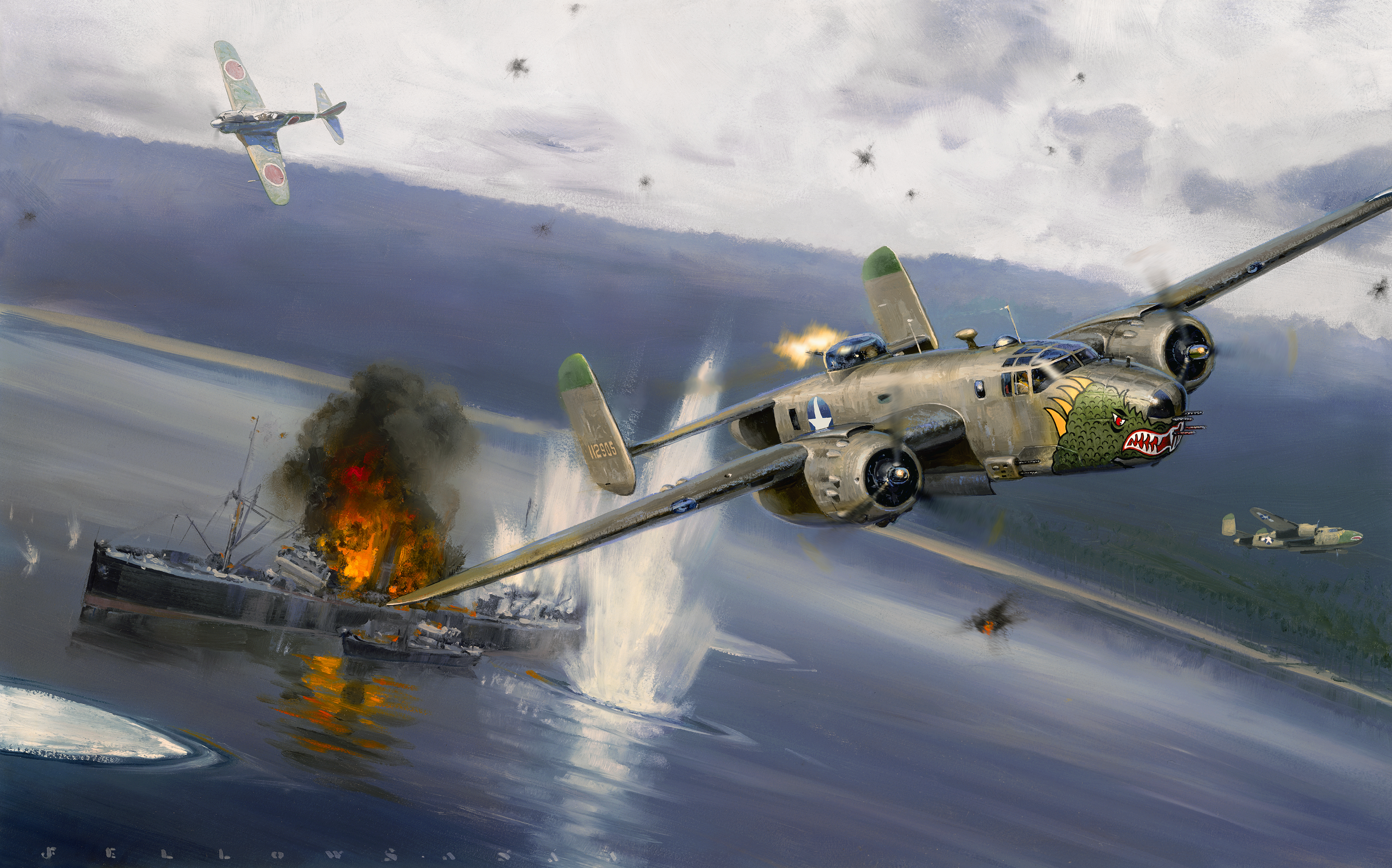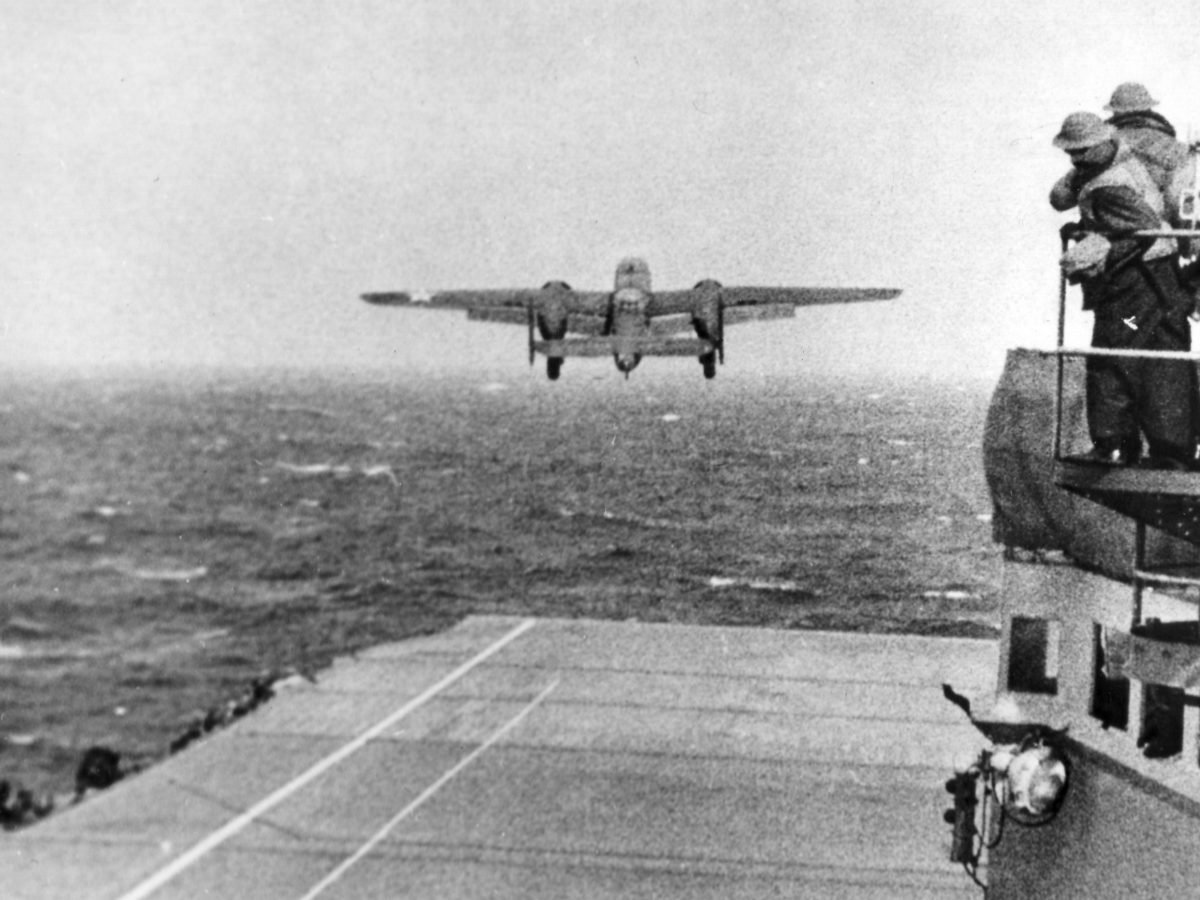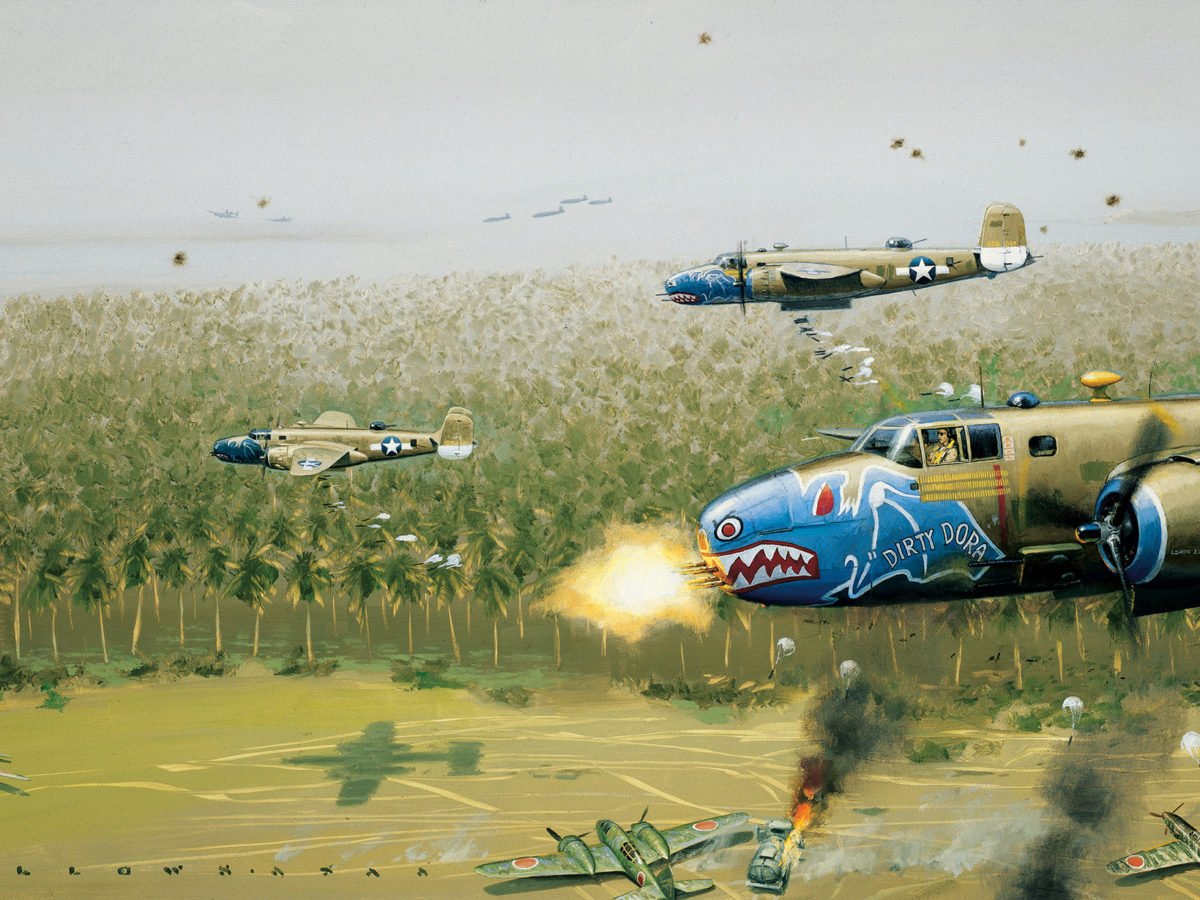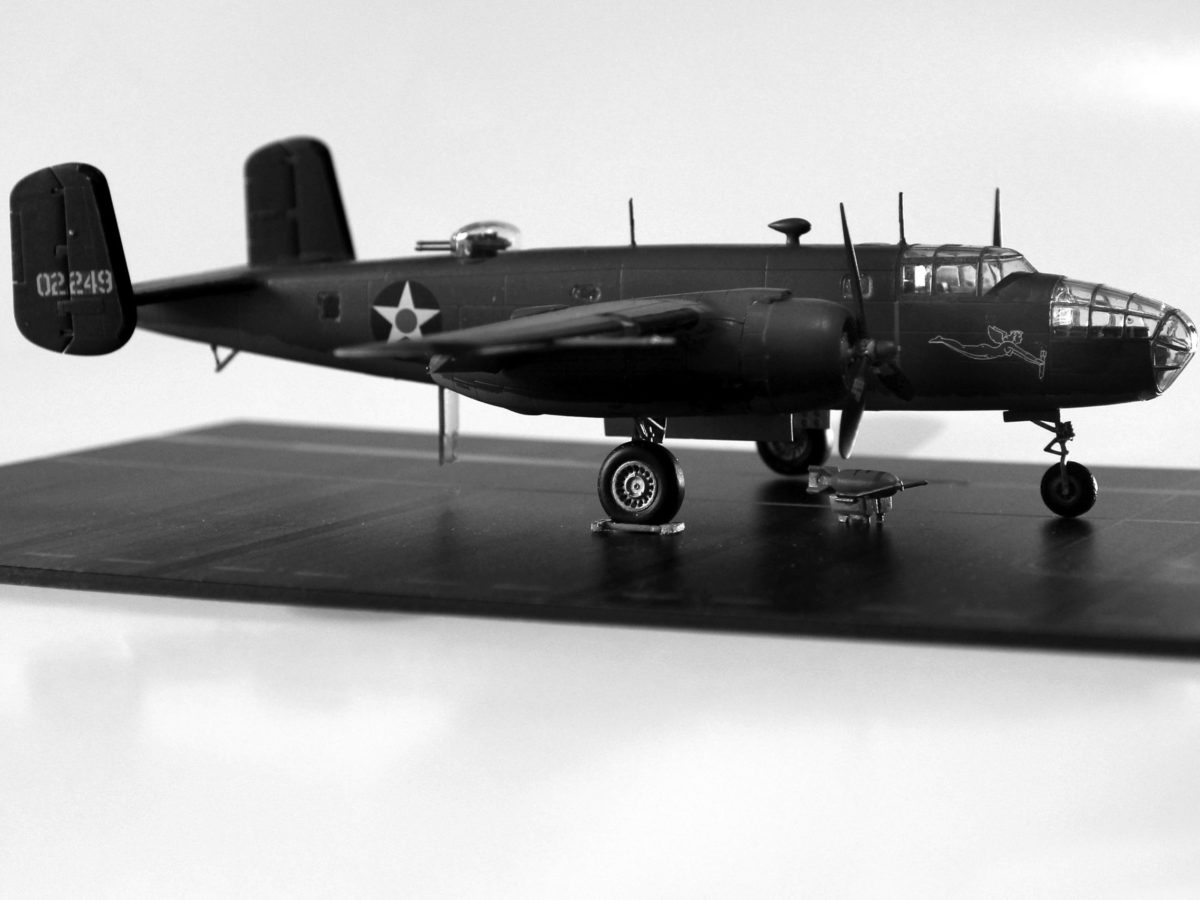The North American B-25 Mitchell was present for the overture of the Pacific War and was still onstage as the curtain fell on the final act. On April 18, 1942, 16 B-25Bs flew one of the first American offensive missions of the war—the famous “Thirty Seconds Over Tokyo” Doolittle Raid. On August 19, 1945, four B-25J gunships escorted a surrender-negotiation delegation aboard two Mitsubishi Betty bombers from Japan partway to Manila and back.
Recommended for you
Among American aircraft, only the Boeing B-17 had a longer combat career. The Fortress began flying raids for the Royal Air Force in July 1941, and a dozen unarmed B-17s were in the air during the Pearl Harbor attack five months later.
The B-25 finished World War II virtually unchanged from the form in which it had been born. From the A model to the J, the airframe remained unstretched, the flying and control surfaces were constant and the engines were unchanged other than detail mods—different exhaust systems, carburetors and the like. The single biggest difference as the Mitchell aged and improved was its ordnance—guns that grew and proliferated in a manner that totally changed the airplane’s mission. By the end of the war, the B-25 was the most heavily armed aircraft in the U.S. Army Air Forces’ inventory. A single 12-airplane squadron of B-25s carried more .50-caliber machine guns than four infantry regiments.
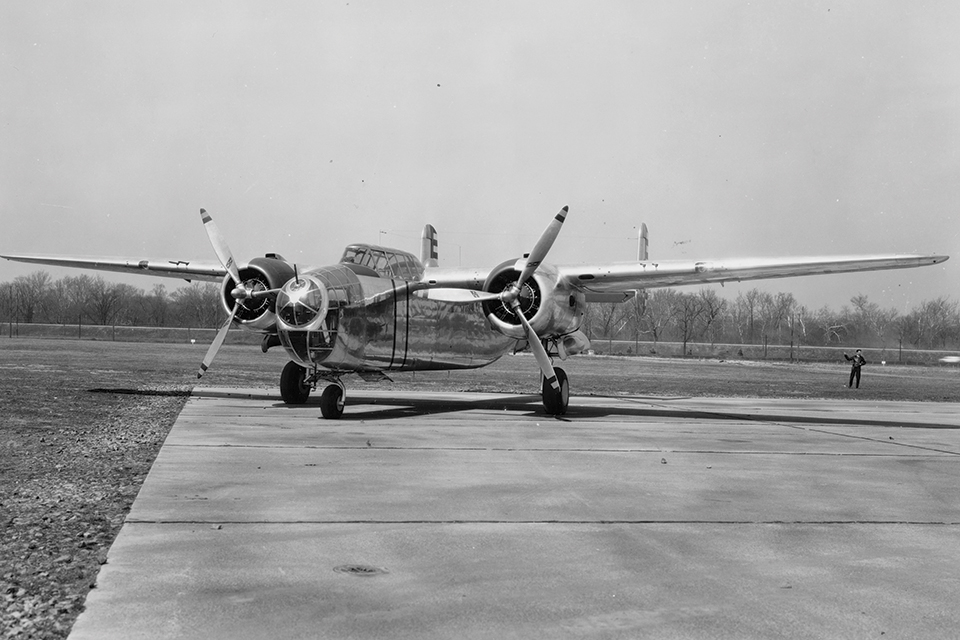
The B-25 was intended to be a medium bomber, delivering substantial bombloads more economically, more rapidly and more accurately, from moderate altitudes, than the high-altitude heavyweight B-17s and B-24s. But it found its true calling as a low-level attack bomber and strafer.
Economy had a lot to do with the B-25’s success. It was substantially cheaper to manufacture than either of its rivals—the more innovative Martin B-26 Marauder and the Douglas A-20 Havoc. It took 25 percent fewer man-hours to build a B-25 than to produce a B-26. Thanks largely to the stewardship of company president James “Dutch” Kindelberger, North American Aviation was the best-organized, most efficient airframer in the industry, able to simultaneously produce in huge numbers three of the most important aircraft of WWII: the AT-6 Texan, P-51 Mustang and B-25.
Kindelberger was a production guy. He emphasized the use of major subassemblies and of subcomponents that could easily be combined into larger components, rather than hand-fabricating an entire aircraft. His engineers, including Edgar Schmued of P-51 fame, concentrated on designing with the manufacturing process in mind.
Throughout the process of prototyping and producing what became the B-25, North American’s proposals were also carefully conservative. While many other manufacturers were drawn to the hot new Pratt & Whitney R-2800 engine, the Army Air Corps required that North American stay with the well-developed though less powerful Wright R-2600 Twin Cyclone. The War Department wanted a medium bomber that could be put into production quickly, not a couple of prototypes that would spend a year dealing with unproven-engine problems.
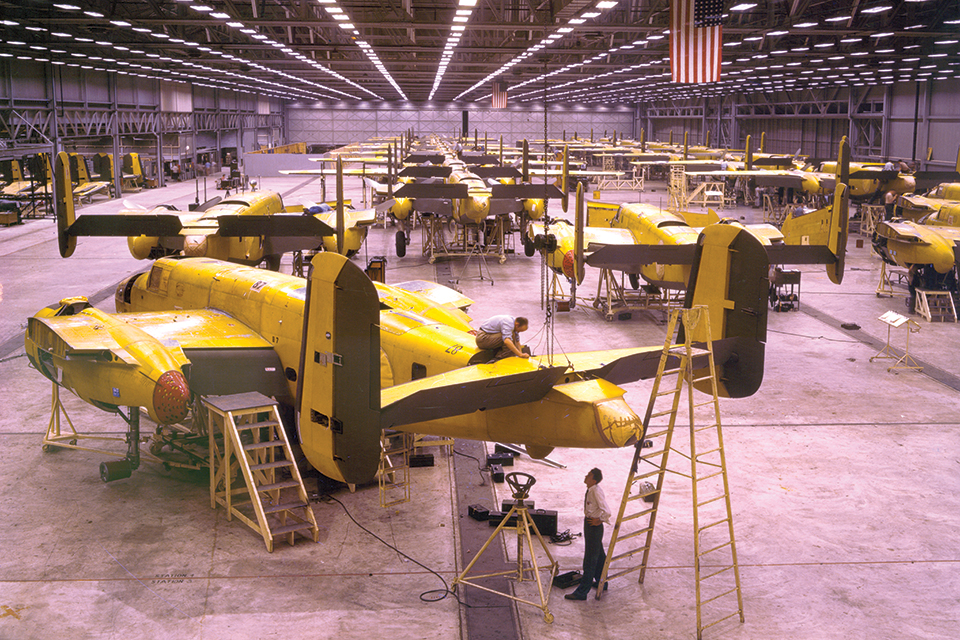
NAA had planned to use Pratt R-1830s—DC-3 engines, basically—and one of the key elements in the B-25’s success was the move to the more powerful and modern R-2600. This was a result of the war that had already begun in Europe, where reports from the front caused the Air Corps to upgrade the requirements for its new “attack bomber” by 100 mph (to a top speed of 350) and its operating altitude from 5,000 feet to 20,000. In fact, the first major production model, the B-25A, added armor plating for the crew and self-sealing fuel tanks, both because of lessons learned in early combat over Britain and the Continent.
For the same reason, the B-25B got heavier defensive armament, replacing some of the airplane’s .30-caliber guns with .50s and adding a powered dorsal turret as well as a useless, remotely aimed and fired retractable ventral gun package. (It was soon removed.)
The B-25’s gestation began with the 1936 XB-21 Dragon, a sow-bellied taildragger with single vertical tail. North American had a thing for the Dragon name, which they would much later apply to the stillborn B-25 replacement, the B-28. NAA built only one XB-21 and decided it was a dumb idea—an archaic airframe paired with obsolete Pratt & Whitney R-2180-A transport engines.
In 1938 North American got an order from the RAF for 400 AT-6 trainers (the British renamed them Harvards), giving NAA the money and breathing room to get serious about its medium bomber proposal. The result was the NA-40 and then the NA-62, the granddaddy and daddy, respectively, of the B-25. Both were tri-gear and twin-tailed. It’s not clear why North American decided to use an archaic twin tail on the B-25, but one supposition is that it gave the top-turret gunner a clear field of fire directly aft.
GET HISTORY’S GREATEST TALES—RIGHT IN YOUR INBOX
Subscribe to our HistoryNet Now! newsletter for the best of the past, delivered every Monday and Thursday.
One of the major aerodynamic advances North American made with the B-25 was to mount the engine nacelles entirely under the wings rather than clamping them onto the leading edge, DC-3-fashion. This allowed the entire unobstructed upper surface of the wing to do useful work.
But that wing also did something less welcome: The first test flights revealed that in combination with the minimal sail area of the two vertical stabilizers, the wing’s dihedral created a drunken, unstable wallow called Dutch roll, particularly when the Norden bombsight was trying to control the autopilot. Not a useful quality for a bomber that needed straight-and-level flight to put its bombs anywhere near a target.
North American quickly came up with an economical solution that ultimately gave the Mitchell its unusual broken-wing look. Without having to do any reengineering of the wing center section, main landing gear or engine nacelles, NAA simply relocated the wings outboard of the nacelles to a very slightly anhedral position—just over a third of a degree down—while retaining the original four-degree dihedral of the inboard wing panels. Call it a gull wing or a broken-dihedral wing, it remained constant throughout the airplane’s long career.
Unlike Martin’s B-26, which got a reputation for being hard to handle due to its high wing loading, the B-25 went to war with thousands of newly minted pilots flying it with no problem. Latter-day B-25 pilot Jim Harley knows why. With more than 600 hours in the Collings Foundation’s Tondelayo, he found the airplane “rock-stable…painfully easy on takeoff…and one of the most stable platforms in the landing configuration of any airplane I’ve ever flown, other than maybe the Mustang.
“Single-engine control speed was probably the biggest thing to be concerned about. It was around 145 mph, and you lifted off at 90 to 100. Get it off the ground, get the gear coming up, level the airplane over the runway and let it accelerate to 145. Then you can go right into the climb. Takes 20, 30 seconds. It accelerates really fast.” Single-engine control speed (Vmc) is the airspeed needed for the rudders and ailerons to be effective enough to overcome the asymmetric thrust created by a dead engine. Below Vmc and with full power on the remaining engine, a twin-engine airplane will uncontrollably roll inverted and crash.
“The hardest part of teaching somebody to fly a B-25 is teaching them how to taxi, since the nosewheel doesn’t steer but casters free,” Harley says. “If you don’t have a feather touch on the brakes, the airplane jerks all over the place. The brakes will heat up pretty fast and they’ll fade, and then you don’t have any brakes at all. If you cock the nosewheel on the runup pad and let the airplane creep, it’ll turn sideways. Then you have to shut down and get out the towbar.”
Harley says the Mitchell’s prime strength is “its maneuverability for its size. I always likened it to a twin-engine Mustang. The one airplane I’d have liked to take into combat was the B-25. It’s not at all cumbersome—it’s a wonderful, rock-stable platform for combat.”
Much is made of the Doolittle Raiders’ gamble in taking off from a carrier deck, but the B-25’s short-field performance was actually so good that with the carrier Hornet’s steaming speed plus the wind over the deck, liftoff wasn’t a problem. One Doolittle crew forgot to set takeoff flaps, so their departure was a bit shaky, and of course Vmc was but a distant goal for the departing bombers, so an engine failure would have meant ditching straight ahead at best.
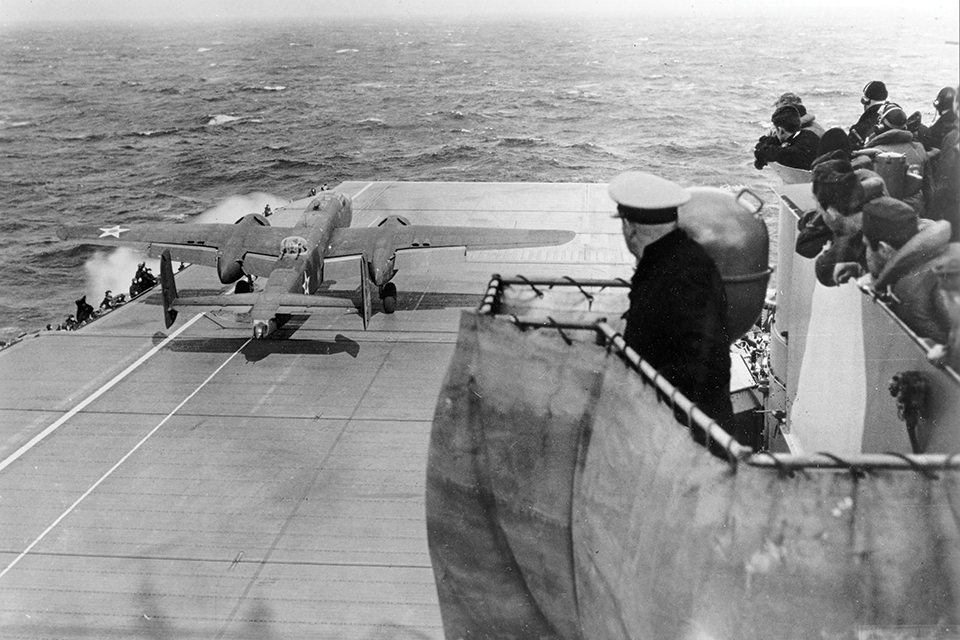
Harley admits that the B-25’s Wright engines might not have been as desirable as their Pratt & Whitney counterparts. “We were concerned about the engines when the Collings Foundation took the B-25 on the road. They do have a reputation for being fragile….But remember, these were 50-hour engines. That’s as long as they needed to last. If it went bad, just give me another one.”
In the Mediterranean and European theaters, B-25s largely operated as strategic level bombers, missions memorialized in Joseph Heller’s novel Catch-22, a result of the novelist’s own service as a bombardier with the Corsica-based 340th Bomb Group. In the Pacific, however, B-25s found their forte and had an immense impact on aerial tactics and attack methodology.
This happened thanks to the man who ran the Southwest Pacific Fifth Air Force, Lt. Gen. George C. Kenney. He was “born 300 years too late, a natural-born pirate,” said his boss, Douglas MacArthur. Kenney, a talented pilot himself, scored two air-to-air victories during World War I and never saw a gun he didn’t love. What particularly fascinated him were the possibilities offered by combining them with aircraft. The more the merrier seemed to be his operating principle.
The B-25 originally had a cumbersome and ineffective suite of defensive armament, including a peashooter .30-caliber nose gun. The Mitchell also carried a waist gunner who alternated between two .30s, plus a power dorsal turret and a ventral gun tray that took almost a minute to extend. Once it was finally in place, the gunner often found himself nauseated by trying to look through the periscopic sight. The waist guns posed as much of a danger to the B-25’s vertical tails and engine nacelles as they did to enemy fighters. The tail gunner manned the most useful position of all—the B-25 was one of the first bombers to have a tail gun.
The Fifth Air Force had already begun up-arming A-20 Havocs with fixed nose guns in the fall of 1942 when longer-range, more capable B-25s began arriving in the Southwest Pacific. Kenney’s aptly named pal Paul Gunn, who would forever be known as Pappy, did the engineering and fabricating to turn his airplanes into what they called “commerce destroyers”—anti-shipping strafers. Initially, Gunn used .50-caliber Brownings stripped from wrecked fighters to crank up the volume on Kenney’s A-20s.
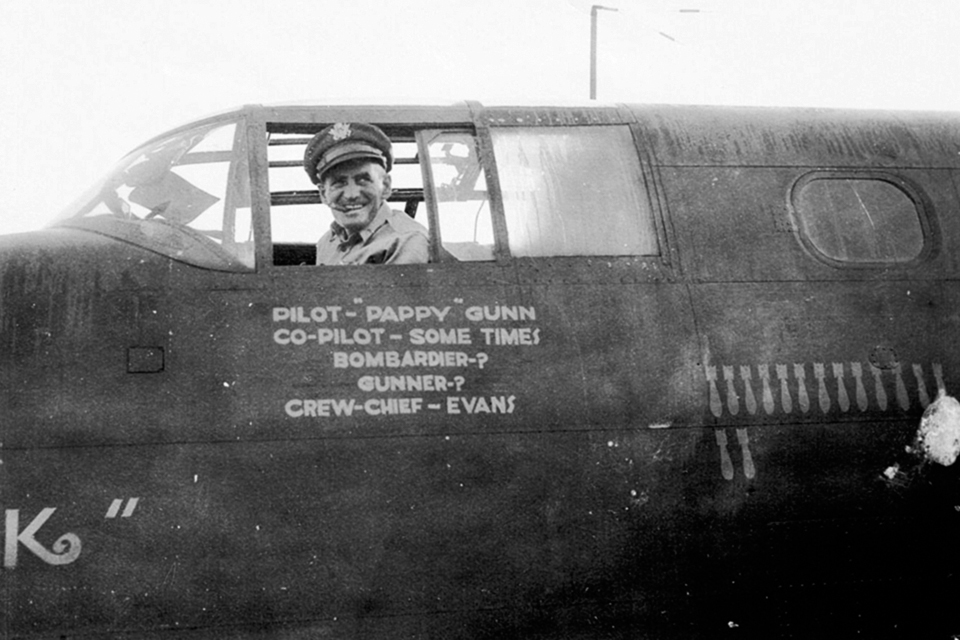
Gunn deserved his nickname, unlike the 29-year-olds who only seemed like old men to teenage crewmen. Pappy, in his mid-40s, had already finished a 21-year career as an NCO naval aviator when the Air Corps persuaded him to re-up with a captain’s commission. He was a junkyard genius who could fix, rig, fabricate or negotiate the solution to any mechanical problem, and he ultimately equipped Kenney’s B-25s with as many as eight fixed .50s in a hard nose, plus four more in external “cheek” pods affixed to the fuselage slightly behind and below the cockpit on each side. Add in the top turret rotated to fire straight ahead and you had a battery of 14 .50-caliber machine guns with a total throw weight of about 215 pounds per second. One version of the late-model B-25J had 18 forward-firing machine guns.
One of the earliest uses of the Gunn strafers was in the March 1943 Battle of the Bismarck Sea. It was a serious defeat for the Japanese, who were trying to resupply their garrisons on New Guinea. The B-25s not only strafed but used to good effect two tactics developed with the help of the RAF and Royal Australian Air Force: skip bombing and mast-height bombing. Twelve of Gunn’s B-25 strafers from the 3rd Bomb Group skip-bombed and sank four cargo vessels and two destroyers in the first 15 minutes of their first combat mission. Low-level specialists, 3rd Group pilots claimed that if they came across a cow during a mission, they simply flew around it.
Skip bombing sometimes wasn’t true to its name, which implied a bomb rocketing toward a ship like a flat stone flung across a pond. Often skip bombing meant literally throwing a bomb against a hull, and the B-25’s speed made it particularly effective at this. Skip bombing had first been tried with B-17s, but they weren’t fast enough to get the job done.
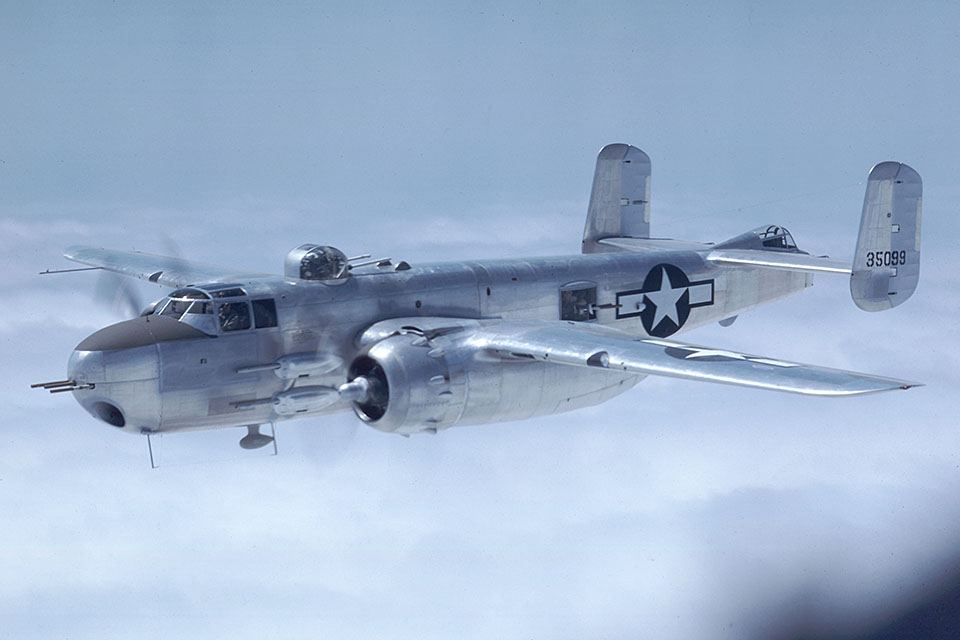
Strafing Japanese airfields was a primary B-25 mission. Blowing up enemy fighters and bombers in their revetments would never make anybody an ace, but destroying airplanes on the ground was just as useful as shooting them down. B-25 strafers in the European theater even used special “jet ammunition,” developed to ignite the fuel in Messerschmitt Me-262s and other jets. They destroyed a large number of the parked German jets during April 1945 alone.
Though many ground targets were hard for B-25 strafers to find under their camouflage, bridges were an exception. One Mitchell unit operating in Burma, the 409th Bomb Squadron, became so good at destroying bridges that it named itself the Dental Clinic…for its bridgework.
Unfortunately, Gunn’s most famous gun installation—the 75mm short-barrel tank cannon he mounted in the belly of a number of B-25Gs—was his least successful. Intended to sink destroyer-size ships and troop-transport barges with one or two rounds, it was briefly productive as a maritime marauder and became standard on the B-25H. But by early 1944, floating targets were increasingly scarce, and soon the big cannon was being stripped out of Mitchells by units that found it hard to operate, punishing to airframes and unpleasant to use. It popped rivets, filled cockpits with smoke and cordite and assaulted crewmen’s ears.
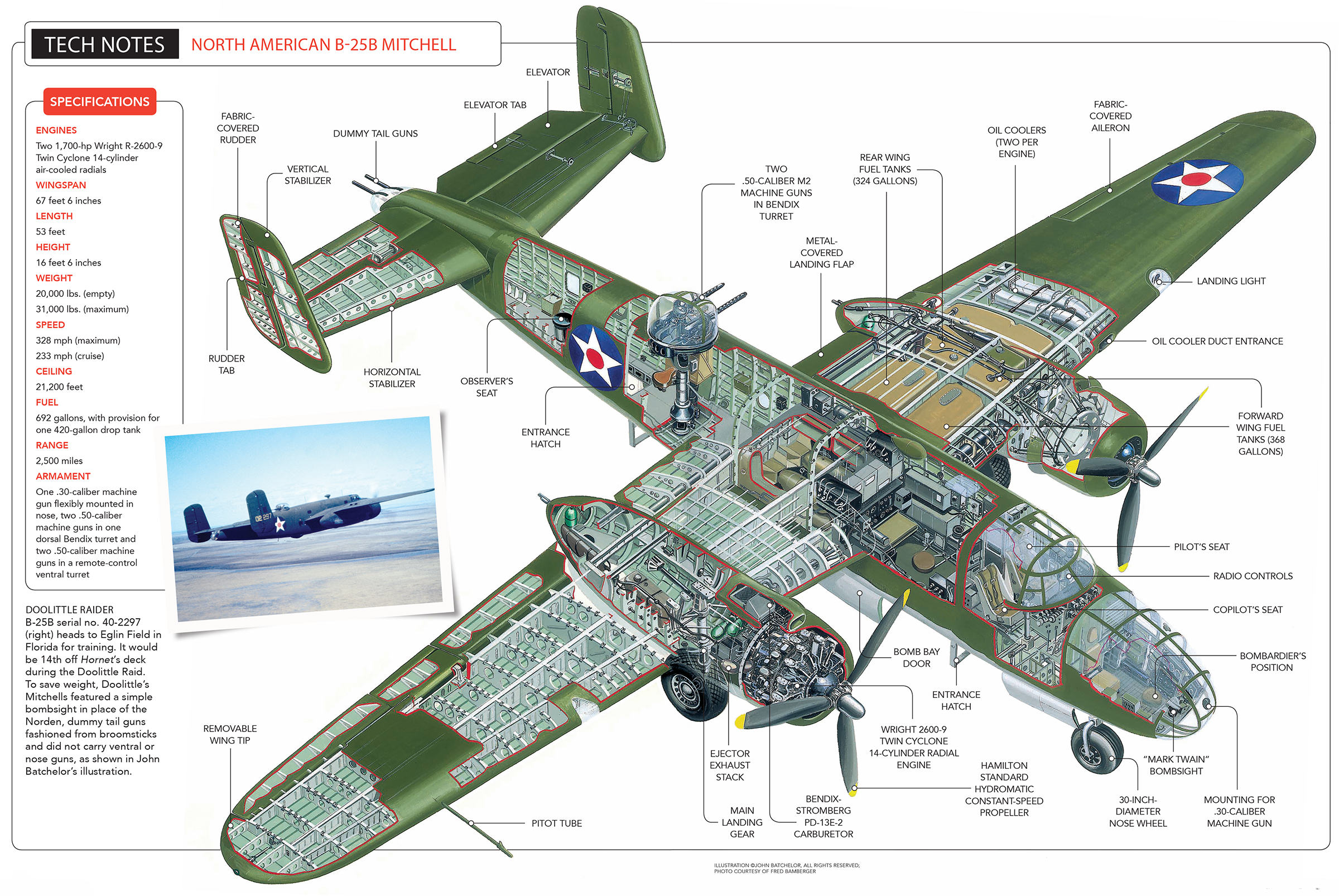
Some B-25s went to the U.S. Navy, which had done little to create its own attack bomber. The Navy had planned to use heavily armed Boeing PBB Sea Ranger flying boats as its anti-sub and long-range patrol aircraft, but the Sea Ranger was canceled when it became obvious that the Army and Marines would be taking Pacific islands that could serve as bases for more-efficient landplanes.
The USAAF was loath to provide the 900 B-25s that the Navy brashly demanded, but eventually 706 slightly navalized versions, designated PBJs, wound up being flown mostly by the Marine Corps. Crews had to be rapidly trained, since the Marines had no experience with anything but single-seat aircraft. PBJs came in as wide a variety of configurations as did the AAF’s B-25s, including some with the 75mm cannon. Even the Coast Guard operated a few PBJs, making the B-25 one of the few fixed-wing aircraft ever to be flown by all four services.
In February 1942 North American began test-flying its intended B-25 successor, the B-28 Dragon, a single-tail, pressurized medium bomber with R-2800 engines, capable of 372 mph at 35,000 feet. It had three remotely controlled Sperry twin-.50 turrets—dorsal, ventral and tail—and with its cigar-shaped fuselage and long nose looked much like a B-26 Marauder. Only two prototypes were built, and one lost its vertical tail while running high-speed stability tests. In a vote of confidence for the Mitchell, the AAF decided to end the program, since the B-25 was doing so well they didn’t see the need for any major improvement.
Instead, in 1944 the AAF asked North American to add R-2800s and other upgrades to the B-25 to create a super-strafer rivaling the more expensive 14-gun Douglas A-26 Invader. It was given the company designation NA-98X and was not a success. Overweight and with little performance improvement to show for the more powerful engines, the lone prototype crashed in April 1944 when a hotshot test pilot pulled the wings off during a showoff low pass and hard pullup. The AAF terminated development of what might have been the ultimate B-25.
Though it started life as a mid-altitude level bomber, the B-25 became the most formidable low-level attack aircraft of World War II. And it retained its bombing capability: Beat to death the ground gunners by strafing, then drop the bombs on the way out, whether attacking ships, bridges or airfields. The Mitchell was the most heavily armed strafer of the war, and it was built in far greater numbers than any of its competitors.
Easy to fly, hard to knock down, the B-25 never gained the B-17’s iconic status, but it was in some ways the A-10 of its day: never fully appreciated yet always ready to do what no other bomber could.
Contributing editor Stephan Wilkinson suggests for further reading: North American B-25 Mitchell: The Ultimate Look, by William Wolf; The Saga of Pappy Gunn, by George C. Kenney; Air Apaches, by Jay A. Stout; and North American B-25 Mitchell, by Frederick A. Johnsen.
This feature appeared in the May 2020 issue of Aviation History. To subscribe click here!
Click here and build your own B-25B “Doolittle Raider.”
historynet magazines
Our 9 best-selling history titles feature in-depth storytelling and iconic imagery to engage and inform on the people, the wars, and the events that shaped America and the world.


